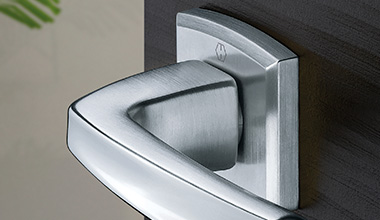Electronic Hardware
Keyless Electronic Multipoint Locking,
A First-time Application for North America
“I don’t want to use keys to enter my house. I haven’t used keys for my car for years. Why can’t I do this for my front door?” This was the simple request from a client seeking a hardware solution. He was building a new home featuring modern architecture, energy-conscious building products and a lot of technology. His exterior doors already had multipoint locks, which required the undesirable key to unlock. We had a solution to eliminate the key. However, this would be a first-time application.
The product we selected was a motor driven, electronically controlled multipoint lock. The solution combines the superior weather sealing performance of a multipoint lock with unprecedented electronic capabilities for the user such as keyless entry. The lock features hook style auxiliary lock points and anti-panic egress. The anti-panic egress allows for easy operation from the interior and is independent from the electromechanical drivetrain. Egress is assured even in the event of a power loss. The lock can be operated by key from the exterior if power is disrupted, but only if the user knows where they left their keys!
Two accessories supplied with the lock provide several additional benefits. First, a 3-pin spring-loaded electrical contact transfers 12V DC power from the frame into the door eliminating the hassle and complexity of a wired connection. Second, an electronic controller manages the operation of the lock. It passes a signal received from a user interface, such as a keypad, to the motor of the lock to retract the locking points. The controller also triggers the lock to engage after the door closes securing the opening automatically. It features an LED status indicator and even has a toggle switch that disables the locking function. The toggle function is ideal to accommodate special user events such as a party. Guests can pass freely through the unlocked door. The latching function remains active allowing the door to continue to perform its most basic function, to separate interior and exterior.
This first-time application was not without its challenges. The path to success was unique and different from our usual product implementation. The most noticeable difference was the need to collaborate with several professional disciplines. The builder had to arrange modifications to the doors and frames which involved a skilled millworker. Electricians had to route power to the doors. An electronic systems integrator had to connect the locks to the power source and to the user interface, a keypad with a fingerprint reader in this case. A local hardware distributor had to support a solution for the handle sets with guidance from the architect. The home owner had to keep everything coordinated and moving in the right direction.
Ultimately, the first-ever residential use of electronic multipoint locks in North America was a success. Certainly, there are others in our industry embarking on this same challenge to combine electronic tech with fenestration. Our advice: find the best professionals to support your endeavor. We found that highly trained, dedicated professionals were critical for success. Looking ahead, we plan to leverage the knowledge gained from this experience to continue to tackle the cross-industry challenge of combining electronic controls and automation with fenestration. We are eager to meet the demands of a growing market for home automation, connectivity, performance and users who want to rid themselves of those pesky keys.

